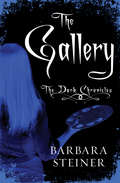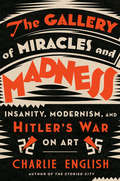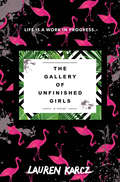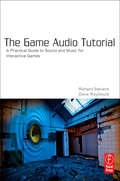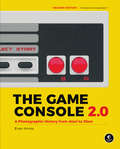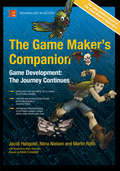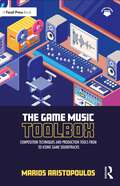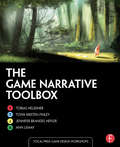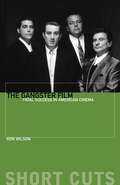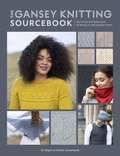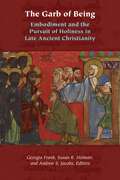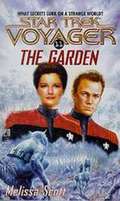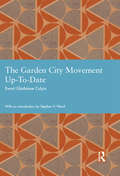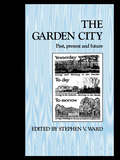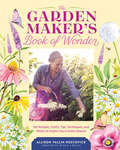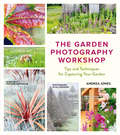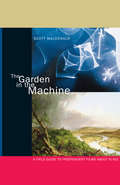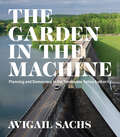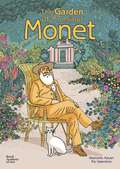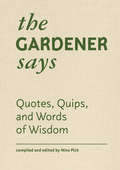- Table View
- List View
The Gallery (The Dark Chronicles #2)
by Barbara SteinerWhen a high schooler gets a job in the art department of a nearby university, she begins to suspect that the campus is haunted by a ghost—and maybe even a serial killerLaDonna Martindale hopes that her new job at the local college will help to inspire her own painting. But every night, in the art school basement, she sorts canvases for the upcoming gallery showing. And every night, she feels the same strange, comforting presence of someone in the basement with her—even if she can&’t see him. When LaDonna suddenly discovers a beautiful painting on the basement wall that wasn&’t there before, she realizes that her ghost is an incredible artist. Maybe, just maybe, he can be the muse she&’s been lacking. But when a string of murders on campus turns her small town upside down, LaDonna isn&’t sure whom to trust—her best friend, Johnny; the art school director; or even her ghost. LaDonna can sense someone stalking her whenever she&’s on campus, and she starts to wonder if she might be the serial killer&’s next victim.
The Gallery of Miracles and Madness: Insanity, Modernism, and Hitler's War on Art
by Charlie EnglishThe untold story of Hitler&’s war on &“degenerate&” artists and the mentally ill that served as a model for the &‘Final Solution&’. &“Dazzling . . . Richly wrought and deeply researched, it&’s also a salient reminder to beware of pseudoscience.&”—Susannah Cahalan, author of Brain on Fire and The Great Pretender As a veteran of the First World War, and an expert in art history and medicine, Hans Prinzhorn was uniquely placed to explore the connection between art and madness. The work he collected—ranging from expressive paintings to life-size rag dolls and fragile sculptures made from chewed bread—contained a raw, emotional power, and the book he published about the material inspired a new generation of modern artists, Max Ernst, André Breton, and Salvador Dalí among them. By the mid-1930s, however, Prinzhorn&’s collection had begun to attract the attention of a far more sinister group. Modernism was in full swing when Adolf Hitler arrived in Vienna in 1907, hoping to forge a career as a painter. Rejected from art school, this troubled young man became convinced that modern art was degrading the Aryan soul, and once he had risen to power he ordered that modern works be seized and publicly shamed in &“degenerate art&” exhibitions, which became wildly popular. But this culture war was a mere curtain-raiser for Hitler&’s next campaign, against allegedly &“degenerate&” humans, and Prinzhorn&’s artist-patients were caught up in both. By 1941, the Nazis had murdered 70,000 psychiatric patients in killing centers that would serve as prototypes for the death camps of the Final Solution. Dozens of Prinzhorn artists were among the victims. The Gallery of Miracles and Madness is a spellbinding, emotionally resonant tale of this complex and troubling history that uncovers Hitler&’s wars on modern art and the mentally ill and how they paved the way for the Holocaust. Charlie English tells an eerie story of genius, madness, and dehumanization that offers readers a fresh perspective on the brutal ideology of the Nazi regime.
The Gallery of Unfinished Girls
by Lauren KarczA beautiful and evocative look at identity and creativity, The Gallery of Unfinished Girls is a stunning debut in magical realism. Perfect for fans of The Walls Around Us and Bone Gap. Mercedes Moreno is an artist. At least, she thinks she could be, even though she hasn’t been able to paint anything worthwhile in the past year. Her lack of inspiration might be because her abuela is in a coma. Or the fact that Mercedes is in love with her best friend, Victoria, but is too afraid to admit her true feelings. Despite Mercedes’s creative block, art starts to show up in unexpected ways. A piano appears on her front lawn one morning, and a mysterious new neighbor invites Mercedes to paint with her at the Red Mangrove Estate.At the Estate, Mercedes can create in ways she hasn’t ever before. But Mercedes can’t take anything out of the Estate, including her new-found clarity. Mercedes can’t live both lives forever, and ultimately she must choose between this perfect world of art and truth and a much messier reality. “A dreamy and subtle work of art, The Gallery of Unfinished Girls explores love, family, and the maddening, magical drive to create art.”—Adi Alsaid, author of Let's Get Lost
The Game Audio Tutorial: A Practical Guide to Creating and Implementing Sound and Music for Interactive Games
by Richard Stevens Dave RaybouldDesign and implement video game sound from beginning to end with this hands-on course in game audio. Music and sound effects speak to players on a deep level, and this book will show you how to design and implement powerful, interactive sound that measurably improves gameplay. If you are a sound designer or composer and want to do more than just create audio elements and hand them over to someone else for insertion into the game, this book is for you. You'll understand the game development process and implement vital audio experiences-not just create music loops or one-off sound effects. The Game Audio Tutorial isn't just a book-you also get a powerful website (www.thegameaudiotutorial.com)
The Game Console 2.0: A Photographic History from Atari to Xbox
by Evan AmosThis revised and expanded second edition of the bestselling The Game Console contains brand new content, with coverage of 50 more consoles, variants, and accessories in 50 added pages. The Game Console 2.0 is a gorgeous coffee table book for geeks and gamers that brings together highly detailed photos of more than 100 video game consoles and their electronic interiors spanning nearly five decades.Revised and updated since the first edition&’s celebrated 2018 release, The Game Console 2.0 is an even bigger archival collection of vividly detailed photos of more than 100 video-game consoles. This ultimate archive of gaming history spans five decades and nine distinct generations, chronologically covering everything from market leaders to outright failures, and tracing the gaming industry&’s rise, fall, and monumental resurgence. The book&’s 2nd edition features more classic game consoles and computers, a section on retro gaming in the modern era, and dozens of new entries — including super-rare finds, such the Unisonic Champion 2711, and the latest ninth-generation consoles. You&’ll find coverage of legendary systems like the Magnavox Odyssey, Atari 2600, NES, and the Commodore 64; systems from the &‘90s and 2000s; modern consoles like the Nintendo Switch, Xbox Series X|S, and PlayStation 5; and consoles you never knew existed. Get a unique peek at the hardware powering the world&’s most iconic video-game systems with The Game Console 2.0 — the perfect gift for geeks of all stripes and every gamer&’s must-have coffee-table book.
The Game Maker's Companion
by Kevin Crossley Jacob Habgood Nana Nielsen Martin RijksThe Game Maker's Companion is the long-awaited sequel to The Game Maker's Apprentice. This book picks up where the last book left off, advancing your game development journey with some seriously impressive gaming projects. This time you'll learn how to make professional-quality platform games with solid collision detection and slick control mechanisms and you'll get acquainted with a long-lost icon of platform gaming history on the way. You'll go on to discover techniques to add depth and believability to the characters and stories in your games, including The Monomyth, cut scene storyboarding, and character archetypes. This culminates in the creation of an original atmospheric platform-adventure which will take your GML programming skills to new heights. There's even a handy reference section at the back of the book which will be invaluable for adding common features to your own games. With contributions from four games industry professionals and a highly respected member of the Game Maker community, The Game Maker's Companion is another labor of love that will give you even more hours of enjoyment than the original. If you already own Game Maker then you really must own this book as well. What you'll learn * Learn the fundamentals of how to create platform games with nature's first platform game character: Fishpod. * Discover how to recreate the classic 90's platform game Zool (Ninja of the Nth Dimension) entirely using drag-and-drop programming. * Learn how to extend and improve upon the drag-and-drop functionality of Game Maker using GML scripts. * Follow the design of the atmospheric platform-adventure game OC Shadows on Deck from original concept to a completed vertical slice of gameplay. * See how professional designers create engaging storylines with believable characters. * Learn how to modify the Shadows on Deck artwork to include in your own games. * Experience a practical journey into game development which has been unparalleled since The Game Maker's Apprentice. * Gain access to professional game resources from Shadows on Deck which you are free to use in your own Game Maker games. Who this book is for This book is for Game Maker's Apprentice readers, along with other game developers in general. Table of Contents * Greetings, Game Maker * Platform Beginnings: An Idea with Legs * Zool: Taking It to the Nth Dimension * Empowerment: Sliding Ninjas * Krool's Forces: Sweetening the Challenge * Fighting Talk: The Empower Strikes Back * Game Design: OC Shadows on Deck * Storytelling in Theory * Storytelling Applied * Of Mice and Pen: Pirate Art * GML: From Ninja to Pirate * Rogues' Rendezvous: Vertically Sliced * The Story Begins * Feature Reference * Rogues' Rendezvous: Dialogue"
The Game Music Toolbox: Composition Techniques and Production Tools from 20 Iconic Game Soundtracks
by Marios AristopoulosThe Game Music Toolbox provides readers with the tools, models, and techniques to create and expand a compositional toolbox, through a collection of 20 iconic case studies taken from different eras of game music. Discover many of the composition and production techniques behind popular music themes from games such as Cyberpunk 2077, Mario Kart 8, The Legend of Zelda, Street Fighter II, Diablo, Shadow of the Tomb Raider, The Last of Us, and many others. The Game Music Toolbox features: Exclusive interviews from industry experts Transcriptions and harmonic analyses 101 music theory introductions for beginners Career development ideas and strategies Copyright and business fundamentals An introduction to audio implementation for composers Practical takeaway tasks to equip readers with techniques for their own game music The Game Music Toolbox is crucial reading for game music composers and audio professionals of all backgrounds, as well as undergraduates looking to forge a career in the video game industry.
The Game Narrative Toolbox (Focal Press Game Design Workshops)
by Tobias Heussner Jennifer Brandes Hepler Toiya Kristen Finley Ann LemayLearn how to create compelling game storylines. Four experienced narrative designers from different genres of game development have banded together to create this all-inclusive guide on what it's like to work as a writer and narrative designer in the videogame industry. From concept to final testing, The Game Narrative Toolbox walks readers through what role a narrative designer plays on a development team and what the requirements are at every stage of development. Drawing on real experiences, authors Tobias Heussner, Toiya Finley, Ann Lemay, and Jennifer Hepler provide invaluable advice for writing compelling player-centered stories and effective dialogue trees in order to help readers make the switch from prose- or screen- writing to interactive. Accompanying every chapter are exercises that allow the reader to develop their own documentation, outlines, and game-dialogue samples for use in applying for industry jobs or developing independent projects. This first installment of Focal Press's Game Design Workshops series is a must-have for individuals looking to create captivating storylines for games.
The Gamin de Paris in Nineteenth-Century Visual Culture: Delacroix, Hugo, and the French Social Imaginary (Routledge Research in Art History)
by Marilyn R. BrownThe revolutionary boy at the barricades was memorably envisioned in Eugène Delacroix’s painting Liberty Leading the People (1830) and Victor Hugo’s novel Les Misérables (1862). Over the course of the nineteenth century, images of the Paris urchin entered the collective social imaginary as cultural and psychic sites of memory, whether in avant-garde or more conventional visual culture. Visual and literary paradigms of the mythical gamin de Paris were born of recurring political revolutions (1830, 1832, 1848, 1871) and of masculine, bourgeois identity constructions that responded to continuing struggles over visions and fantasies of nationhood. With the destabilization of traditional, patriarchal family models, the diminishing of the father’s symbolic role, and the intensification of the brotherly urchin’s psychosexual relationship with the allegorical motherland, what had initially been socially marginal eventually became symbolically central in classed and gendered inventions and repeated re-inventions of "fraternity," "people," and "nation." Within a fundamentally split conception of "the people," the bohemian boy insurrectionary, an embodiment of freedom, was transformed by ongoing discourses of power and reform, of victimization and agency, into a capitalist entrepreneur, schoolboy, colonizer, and budding military defender of the fatherland. A contested figure of the city became a contradictory emblem of the nation.
The Gangster Film
by Ron WilsonExamines the gangster film in its historical context with an emphasis on the ways the image of the gangster has adapted and changed
The Gangster Film: Fatal Success in American Cinema
by Ron WilsonExamines the gangster film in its historical context with an emphasis on the ways the image of the gangster has adapted and changed
The Gangster Film: Fatal Success in American Cinema (Short Cuts)
by Ron WilsonThis volume examines the gangster film in its historical context with an emphasis on the ways the image of the gangster has adapted and changed as a result of socio-cultural circumstances. From its origins in Progressive-era reforms to its use as an indictment of corporate greed, the gangster film has often provided a template for critiquing American ideas and values concerning individualism, success, and business acumen. The gangster genre has also been useful in critically examining race and ethnicity in American culture in terms of "otherness." Films studied include Musketeers of Pig Alley (1912), The Racket (1928), The Captive City (1952), The Godfather, Part Two (1974), Goodfellas (1990), and Killing Them Softly (2012).
The Gansey Knitting Sourcebook: 150 Stitch Patterns and 10 Projects for Gansey Knits
by Di Gilpin Sheila GreenwellGanseys are hardwearing sweaters traditionally knitted for fishermen in and around the British Isles. Today, the styling and history of ganseys is as popular as ever and this collection of stitch patterns and projects brings the history of ganseys to a new audience. Learn all about the techniques used for knitting ganseys with this comprehensive sourcebook from experts in the subject, Di Gilpin and Sheila Greenwell. Di and Sheila are knitwear designers and makers based in Scotland where they teach regular workshops on traditional gansey techniques. Discover all the techniques you need to make an authentic gansey sweater with their special features which were developed for warmth and comfort in what were often, harsh conditions out at sea. Ganseys were designed with a special under arm gusset and a shoulder seam which prevented chaffing and improved movement for the wearer even when the jumper got wet and heavy. The authors explain these techniques with step-by-step instructions and artworks so you can replicate these details in your own work. Another key element to the gansey is the stitch pattern which was specific to the local area and often had a symbolism beyond the pattern itself and, some hoped, would act as a charm to keep the fishermen safe while they were out at sea. This collection features a comprehensive directory of 150 gansey stitch patterns so you can choose your favourite designs and motifs and learn which patterns were important to the fishermen in different areas. There are also 10 patterns for garments and accessories so you can practise your skills. The projects include a child's traditional gansey sweater so you can try out your skills on a traditional sweater but on a small scale. There are also some contemporary takes on the traditional gansey using lighter weight yarn and design details: these include a beautiful sweater with a gansey yoke; a contemporary take on the fisherman's kep; a gansey stitch cowl; a pair of mittens and socks; and light linen tank top. The smaller projects such as the mittens and hats are great for practising your skills before you attempt one of the larger projects.
The Garb of Being: Embodiment and the Pursuit of Holiness in Late Ancient Christianity (Orthodox Christianity and Contemporary Thought)
by Georgia Frank, Susan R. Holman, and Andrew S. JacobsThis collection explores how the body became a touchstone for late antique religious practice and imagination. When we read the stories and testimonies of late ancient Christians, what different types of bodies stand before us? How do we understand the range of bodily experiences—solitary and social, private and public—that clothed ancient Christians? How can bodily experience help us explore matters of gender, religious identity, class, and ethnicity? The Garb of Being investigates these questions through stories from the Eastern Christian world of antiquity: monks and martyrs, families and congregations, and textual bodies.Contributors include S. Abrams Rebillard, T. Arentzen, S. P. Brock, R. S. Falcasantos , C. M. Furey, S. H. Griffith, R. Krawiec, B. McNary-Zak, J.-N. Mellon Saint-Laurent, C. T. Schroeder, A. P. Urbano, F. M. Young
The Garden (Star Trek #11)
by Melissa ScottDesperately in need of vital nutritional supplies, the crew of the USS VoyagerTM must risk dealing with an enigmatic race known as the Kirse, legendary for the bountiful crops of their world - and for their secretive ways. Despite Neelix's warnings, Captain Janeway leads an Away Team to the Kirse homeworld. But when the hostile Andirrim attack the Kirse, Janeway finds herself caught in a deadly situation. Forced to fight alongside the Kirse, Janeway and her crew can only hope that their strange, new allies are not more dangerous than their common foe.
The Garden City Movement Up-To-Date (Studies in International Planning History)
by Ewart Gladstone CulpinThis work was written and compiled by the then Secretary of the Garden Cities and Town Planning Association in 1913. It shows just how much the conception of the garden city had been broadened from Howard’s original texts. Indeed the Association’s own name had been broadened to add the newly emergent practice and theory of town planning to the original focus. Alongside the garden city, recognition is now given to the burgeoning numbers of garden suburbs and garden villages. Many examples of these are identified and briefly described, including many which are small and now little known, greatly adding to the interest of the publication. Even the underlying arguments for such developments differ. Alongside the more altruistic arguments in favour of reform, there are now those which explicitly emphasise the need to ensure a healthy race to maintain the Empire.
The Garden City: Past, present and future (Planning, History and Environment Series)
by Stephen WardThis examination of a phenomenon of 19th century planning traces the origins, implementation, international transference and adoption of the Garden City idea. It also considers its continuing relevance in the late 20th century and into the 21st century.
The Garden Maker's Book of Wonder: 162 Recipes, Crafts, Tips, Techniques, and Plants to Inspire You in Every Season
by Allison Vallin KostovickThe joy and wonder of a garden-inspired lifestyle is captured in this colorfully photographed, through-the-seasons sourcebook filled with recipes, gardening wisdom, craft and wellness projects, and nature-based activities. Each season in the garden brings new joy and fresh inspiration for connecting with the wonders of the natural world. In The Garden Maker's Book of Wonder, popular gardening lifestyle influencer Allison Vallin Kostovick (Finch + Folly) invites fans of cottagecore, gardening, and nature-based living to share her journey as she crafts, cooks, dreams, and creates. Drawing on decades of gardening experience, and illustrated with vibrant photography from her own home and garden, The Garden Maker's Book of Wonder offers sage advice on growing bountiful harvests of favorite vegetables, herbs, and flowers. All levels of gardeners, from dreamers to the experienced, will delight in the variety and creativity of Kostovick's projects, activities, and recipes for enjoying the magic and whimsy of the natural world—no matter what season. From planting a pollinator playground to building a rustic trellis from tree branches, cooking with freshly picked peas and mint to making a sweet viola tub soak, and growing a bird seed mix to crafting one-of-a-kind jewelry beads from the husks of the Job's Tears plant, the inventive ideas in this rich treasury are sure to make it a favorite to keep and to give to anyone who aspires to a more nature-connected lifestyle. This publication conforms to the EPUB Accessibility specification at WCAG 2.0 Level AA.
The Garden Photography Workshop: Expert Tips and Techniques for Capturing the Essence of Your Garden
by Andrea JonesLearn to take better garden photos! One of the most rewarding aspects of gardening is sharing its beauty, both physically with those who visit and virtually with those who only see it on a screen. But capturing a garden’s true essence is difficult, and often the moments worth sharing are ephemeral. In The Garden Photography Workshop, internationally known garden photographer Andrea Jones shares the trade secrets that make her photos sing. You’ll learn the basic photography skills and tips on using a range of camera equipment. Profiles of real gardens from around the world exemplify the most common problems a photographer can face, like harsh light, wet weather, and cramped spaces, along with advice and techniques for addressing specific concerns. We live in a photo-driven world, and this helpful guide is a complete tutorial for anyone who wants that world to be filled with beautiful images of gardens and plants.
The Garden in the Machine
by Scott MacdonaldThe Garden in the Machine explores the evocations of place, and particularly American place, that have become so central to the representational and narrative strategies of alternative and mainstream film and video. Scott MacDonald contextualizes his discussion with a wide-ranging and deeply informed analysis of the depiction of place in nineteenth- and twentieth-century literature, painting, and photography. Accessible and engaging, this book examines the manner in which these films represent nature and landscape in particular, and location in general. It offers us both new readings of the films under consideration and an expanded sense of modern film history. Among the many antecedents to the films and videos discussed here are Thomas Cole's landscape painting, Thoreau's Walden, Olmsted and Vaux's Central Park, and Eadweard Muybridge's panoramic photographs of San Francisco. MacDonald analyzes the work of many accomplished avant-garde filmmakers: Kenneth Anger, Bruce Baillie, James Benning, Stan Brakhage, Nathaniel Dorsky, Hollis Frampton, Ernie Gehr, Larry Gottheim, Robert Huot, Peter Hutton, Marjorie Keller, Rose Lowder, Marie Menken, J.J. Murphy, Andrew Noren, Pat O'Neill, Leighton Pierce, Carolee Schneemann, and Chick Strand. He also examines a variety of recent commercial feature films, as well as independent experiments in documentary and such contributions to independent video history as George Kuchar's Weather Diaries and Ellen Spiro's Roam Sweet Home. MacDonald reveals the spiritual underpinnings of these works and shows how issues of race, ethnicity, gender, and class are conveyed as filmmakers attempt to discover forms of Edenic serenity within the Machine of modern society. Both personal and scholarly, The Garden in the Machine will be an invaluable resource for those interested in investigating and experiencing a broader spectrum of cinema in their teaching, in their research, and in their lives.
The Garden in the Machine: Planning and Democracy in the Tennessee Valley Authority (Midcentury)
by Avigail SachsThe Tennessee Valley Authority was the largest single agency created under the auspices of the New Deal legislation. Until 1933, when the project was initiated, the Tennessee Valley was known romantically as "a region of untapped potential" and, less romantically, as one of the most impoverished and isolated areas of the country. The TVA was responsible for three large-scale environmental projects–the river, land, and power machines–but the project also had social, even utopian, goals. In service to the latter, the TVA put together a cadre of regional planners, architects, and landscape architects that Avigail Sachs calls the "atelier TVA." These professionals contributed to the design of the system of multipurpose dams, arranged visitor centers and scenic routes, built housing and communities (although both were segregated), and instigated a regional recreation industry. In addition to its planning and design history audience, this volume will be of interest to environmental historians and historians of the Progressive Era.
The Garden of Monsieur Monet
by Giancarlo Ascari ; Pia ValentinisThe book tells how the Impressionist artist arrived at his garden; about the bright Japanese prints he collected that inspired him; about his famous visitors; how he painted outdoors in all weathers; and about his gardeners, who had to leave Giverny to go to war.
The Gardener Says: Quotes, Quips, and Words of Wisdom (Quotes, Quips, and Words of Wisdom)
by Nina PickThe Gardener Says invites readers to a festive garden party where guests ranging from Gertrude Jekyll and Henry David Thoreau, to Michelle Obama and Michael Pollan share their insights and words of inspiration. Ranging from the humorous to the poignant, these quotes from gardeners, poets, philosophers, and landscape designers highlight both the joys and challenges of gardening—the exhaustion at the end of a long day's work, the satisfaction of seeing a flower blossom, the peace and happiness of time spent in quiet contemplation. A delightful hobby, a potent tool for ecological and social transformation, and a crucial reminder of our place in nature, gardening is, in the words of Mirabel Osler, the one occupation where "if you were to creep up behind someone at their work, you would find them smiling."
The Gardener's Plot: A Mystery
by Deborah J. BenoitA woman helps set up a community garden in the Berkshires, only to find a body in one of the plots on opening day.After life threw Maggie Walker a few curveballs, she’s happy to be back in the small, Berkshires town where she spent so much time as a child. Marlowe holds many memories for her, and now it also offers a fresh start. Maggie has always loved gardening, so it’s only natural to sign on to help Violet Bloom set up a community garden.When opening day arrives, Violet is nowhere to be found, and the gardeners are restless. Things go from bad to worse when Maggie finds a boot buried in one of the plots… and there’s a body attached to it. Suddenly, the police are looking for a killer and they keep asking questions about Violet. Maggie doesn’t believe her friend could do this, and she’s going to dig up the dirt needed to prove it.The Gardener’s Plot takes readers to the heart of the Berkshires and introduces amateur sleuth Maggie Walker in Deborah J. Benoit’s Minotaur Books/Mystery Writers of America First Crime Novel Award-winning debut.
The Gardener's Son: A Screenplay
by Cormac McCarthyThe first screenplay by the Pulitzer Prize–winning author of The Road tells the saga of rival families in post-Civil War South Carolina.Set in Graniteville, South Carolina, The Gardener’s Son is a tale of privilege and hardship, animosity and vengeance. The McEvoys, a poor family beset by misfortune, must work in the cotton mill owned by the Greggs. But when Robert McEvoy loses his leg in an accident—rumored to have been caused by his nemesis, James Gregg—the bitter young man deserts his job and family.Two years later, Robert returns. His mother is dying, and his father, the mill’s gardener, is confined indoors working the factory line. These intertwined events stoke the slow burning rage McEvoy has long carried, a fury that erupts in a terrible act of violence that ultimately consumes the Gregg family and his own.Made into an acclaimed film broadcast on PBS in 1976, The Gardener’s Son received two Emmy Award nominations and was screened at the Berlin and Edinburgh Film Festivals.
